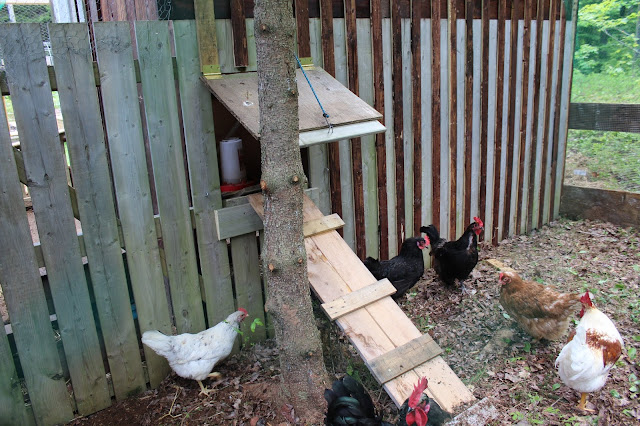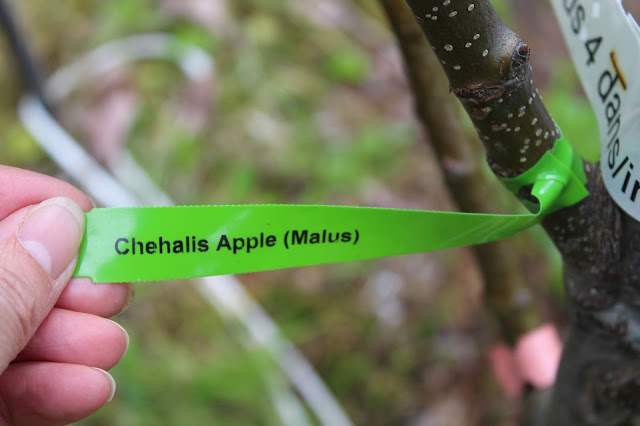So, I bought 3 new trees. Two plum trees and a variegated willow (which is a grafted variegated willow shrub on a different willow species of trunk). I used to have a variegated willow in Iowa, and I really loved it. I buried my dear old rabbit, Thumper, under that tree when she died at the age of 14.
Yesterday, when I planted the new variegated willow, I buried our pet rat Ivy (who died during the winter but had been "cryopreserved" until now) as well as dear Jellybelly, our sweet little serama hen. I don't know exactly why she died, but she declined quickly from Thursday through to Friday evening, and I had her on my lap for a long time before I went to bed. On Saturday morning, she was gone. So Ivy and Jellybelly were sent on their journey back to Mother Earth and they will nourish the growth of the tree, which is planted just beside the bird feeding area.
Jellybelly was a really lovely hen - a tiny bird with a big attitude - she will be missed.
Dear little Ivy died in the winter when the ground was frozen and we couldn't bury her. We miss her too.
The plum trees I bought are both European plum species, and although they are self-fertile, having a second European plum species helps with pollination. One is a Mirabelle plum, which produces a small yellow plum that is sweet and flavourful. They are used in Europe to create the Eau de Vie fruit brandy. The tree is a little smaller than the Mont Royal one, but still healthy and strong. It is a Prunus domestica but has the subspecies syriaca, and is believed to have been cultivated from a wild plum originally grown in Anatolia (now Turkey). There are no plums on it this year.
The other is a Mont Royal plum, in the foreground of the picture below. It is an appropriate plum for my garden because it was originally found growing wild on Mont Royal in the city of Montreal, Quebec, which is my birthplace. It was likely brought over to Canada by an early settler and has spread across North America as a result. It is hardy to zone 4 and remains fairly small (8 feet). It produces blue-purple freestone yellow-fleshed plums.
This tree actually has a few young fruits on it this year, so if I'm lucky and the birds don't get to them first, I might actually have a plum!

Speaking of fruiting trees, I showed my apple tree blossoms a few blogs ago. Now, it looks like I might actually have a few apples this year. The Liberty, Akane and Honeycrisp branches have fruit that looks like it's starting to develop. The Chehalis branch didn't have any blossoms this year.
I bought a wide range of other plants (given that everything was 25% off), many of which were planted today.
Tomatoes: Lemon Boy, Sugary, Jubilee, Scotia
Cantaloupe: Delicious 51 (specifically bred for short season climates)
Yellow Zucchini
Cucamelon (I had planted seeds but they weren't coming on)
Buttercup squash
I also weeded all the raised beds, and harvested our first Pechay Pak Choi! It was tasty in a veggie saute for supper.
I bought and planted several varieties of mint including "After Eight" chocolate mint (Mentha x piperata) which smells divine, apple mint (Mentha suaveolens) pineapple mint (M. suaveolens variegata), and strawberry mint (Mentha x piperata).
I also planted a series of different lavenders (all Lavandula angustifolia) including a couple of classics (Hidcote Blue and Munstead) as well as some new ones to me:
- Mini Blue - a compact selection that only grows to 30 cm (12") tall
- Potpourri Snow - another compact variety that produces snow-white flowers
- Vicenza Blue - a larger 40 cm (16") variety
I planted orange Asclepias tuberosa (butterfly weed) which is a Monarch butterfly food source, as well as a yellow variety (Hello Yellow).
I bought some more ornamental grasses - big bluestem (Andropogon gerardii) and bottlebrush grass (Hystrix patula), both of which are apparently good seed sources for birds in winter. The bottlebrush grass has been planted next to my large pink peony (which is approaching bloom time) and will eventually fill in the space to keep the clematis' roots cool in summer.
I planted an Artemisia "silver mound" to fill in a space where I removed a boatload of creeping buttercup. I planted a "Cobalt Dreams" delphinium, which was developed in New Zealand, and is a lovely deep blue colour in flower.
Finally, I planted a trio of Monarda (bee balm) - one purple, one pink, and one white. I've never had a white one before - it is the "snow white" cultivar. The other two are from the "Sugar Buzz" series and are the Bubblegum Blast and Grape Gumball cultivars. The flowers are just coming out on the Grape Gumball one, and the bees were visiting as I was trying to plant it!
I've planted them in a group so the bees will certainly be visiting them all summer!

























































